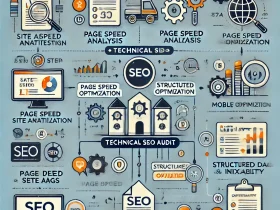Introduction: Why Marketing Metrics and Analytics Matter
In today’s data-driven world, marketing is as much a science as it is an art. Effective marketing requires more than just creativity and compelling storytelling; it demands rigorous analysis and constant measurement to ensure campaigns resonate with audiences and deliver on business objectives. Marketing metrics and analytics give marketers the insights they need to refine strategies, optimize budgets, and maximize ROI.
But with countless metrics to track and analyze, how do you determine which ones matter most? This guide unpacks the essentials of marketing metrics and analytics, explaining which metrics hold the most value and how analytics can transform your marketing strategy from guesswork to data-backed success.
What Are Marketing Metrics?
Marketing metrics are measurable values that show how effectively your marketing activities achieve key performance indicators (KPIs). Metrics provide a clear picture of how various aspects of your marketing perform, allowing you to make informed decisions that drive growth. Marketing metrics can be broken down into categories like engagement, conversion, and financial metrics, each providing different insights into your marketing effectiveness.
Key Types of Marketing Metrics
1. Engagement Metrics
Engagement metrics, such as likes, shares, and comments, are crucial for understanding how audiences interact with your content. High engagement usually signifies that your content is resonating with your audience, while low engagement can highlight areas for improvement.
2. Conversion Metrics
Conversion metrics track how many people complete desired actions, such as signing up for a newsletter, making a purchase, or downloading an eBook. Metrics such as conversion rate, click-through rate (CTR), and cost per acquisition (CPA) are valuable for understanding how well your marketing efforts turn leads into paying customers.
3. Financial Metrics
These metrics, including return on investment (ROI), customer lifetime value (CLV), and cost per acquisition (CPA), focus on the financial outcomes of your marketing activities. They help assess the profitability of campaigns and can influence budget allocation and future investment.
Why Marketing Analytics Is Essential
Marketing analytics takes these metrics a step further by analyzing data to uncover insights, patterns, and trends that help refine marketing strategies. Analytics enables you to move beyond surface-level data, answering critical questions about your audience’s behaviors, preferences, and needs.
How Analytics Supports Marketing Success
- Customer Journey Insights
By analyzing each touchpoint, marketers can see how audiences interact with their brand across multiple channels, helping to optimize each stage of the customer journey. - Campaign Optimization
Analytics provides insights into which campaigns perform best, allowing marketers to reallocate resources effectively and adjust in real time for better outcomes. - Data-Driven Decisions
Marketing decisions based on data are more likely to succeed than those based solely on intuition. Analytics transforms data into actionable insights, empowering marketers to make informed choices that enhance the overall strategy.
Key Marketing Metrics to Track and How to Analyze Them
In a landscape filled with endless metrics, it’s essential to focus on those that drive meaningful results. Below, we’ll discuss several critical marketing metrics and the analytics methods that provide value to each one.
1. Customer Acquisition Cost (CAC)
- What It Is: The cost associated with acquiring a new customer.
- Why It Matters: Knowing your CAC helps in assessing if your marketing budget is effectively driving growth.
- How to Analyze It: Break down CAC by channel and campaign. If one channel has a significantly lower CAC, it may be worth investing more in that area.
2. Customer Lifetime Value (CLV)
- What It Is: The projected revenue that a customer will generate over their lifetime with your company.
- Why It Matters: CLV helps determine how much you can afford to spend on customer acquisition and retention.
- How to Analyze It: Compare CLV across different customer segments. Higher CLV segments could justify a higher CAC, while lower CLV segments may require a different approach to balance profitability.
3. Return on Investment (ROI)
- What It Is: The revenue generated from a marketing campaign relative to its cost.
- Why It Matters: ROI is the ultimate measure of a campaign’s financial success.
- How to Analyze It: Calculate ROI for individual campaigns to assess which ones yield the best returns. If ROI is low, consider adjusting the campaign strategy or targeting a different audience.
4. Engagement Rate
- What It Is: A measure of how well your audience engages with your content (likes, shares, comments).
- Why It Matters: Engagement indicates the quality of your content and its ability to resonate with your audience.
- How to Analyze It: Look at engagement by platform to see where your audience is most active. Test different content types (videos, blogs, infographics) to determine what drives the highest engagement.
Leveraging Analytics Tools for Enhanced Insights
Google Analytics
Google Analytics provides a comprehensive view of website and campaign performance. It allows for granular data analysis by source, behavior, and conversion, helping marketers gain insights into website traffic, user behavior, and engagement metrics.
CRM Analytics
Customer Relationship Management (CRM) systems like Salesforce and HubSpot allow you to analyze customer behavior and lifecycle, helping you understand engagement trends over time. By tracking customer interactions, CRM analytics offer a clear view of the customer journey, from lead generation to conversion.
Social Media Analytics
Platforms like Facebook Insights, Twitter Analytics, and LinkedIn Analytics offer specific tools to track engagement and growth. With data from these tools, you can determine which platforms deliver the best results and where to focus your social media efforts.
Case Study: How Analytics Transformed Marketing Strategy at Company XYZ
To illustrate the power of marketing analytics, consider the story of Company XYZ, a SaaS provider struggling to generate leads through traditional channels. By implementing a data-driven approach, they identified LinkedIn as a high-performing platform and invested in tailored content and LinkedIn ads. This pivot led to a 200% increase in qualified leads and a 50% reduction in customer acquisition cost.
The Future of Marketing Metrics and Analytics: Trends to Watch
- Predictive Analytics
Leveraging AI and machine learning, predictive analytics will allow marketers to forecast outcomes, offering proactive insights instead of reactive data. - Real-Time Analytics
Real-time analytics enable instant feedback, allowing marketers to make adjustments on the fly. This capability is especially valuable in fast-paced environments like social media. - Cross-Channel Attribution
With consumers interacting across various platforms, cross-channel attribution models will become increasingly critical in accurately measuring the impact of each channel on conversions.
Conclusion: Building a Metrics-Driven Marketing Strategy
Effective marketing in today’s digital landscape requires more than a catchy slogan or eye-catching visuals; it demands a deep understanding of metrics and analytics. By focusing on the metrics that matter and employing robust analytics tools, businesses can transform their marketing from a guessing game into a precise science that drives real, measurable results.
Embrace the power of marketing metrics and analytics to gain a competitive edge, optimize your campaigns, and, ultimately, fuel your business’s growth.
For marketers willing to dig deeper, analyze smarter, and act faster, this is not just a guide—it’s a roadmap to mastering marketing through data.
Thanks for diving into this post with us! If you enjoyed the insights, be sure to hit that subscribe button and join the Trendy Talks community for more exciting content!




















Leave a Reply